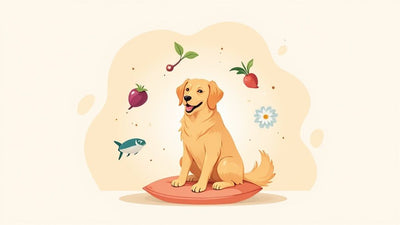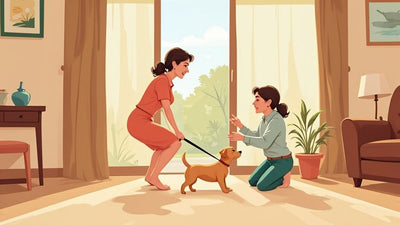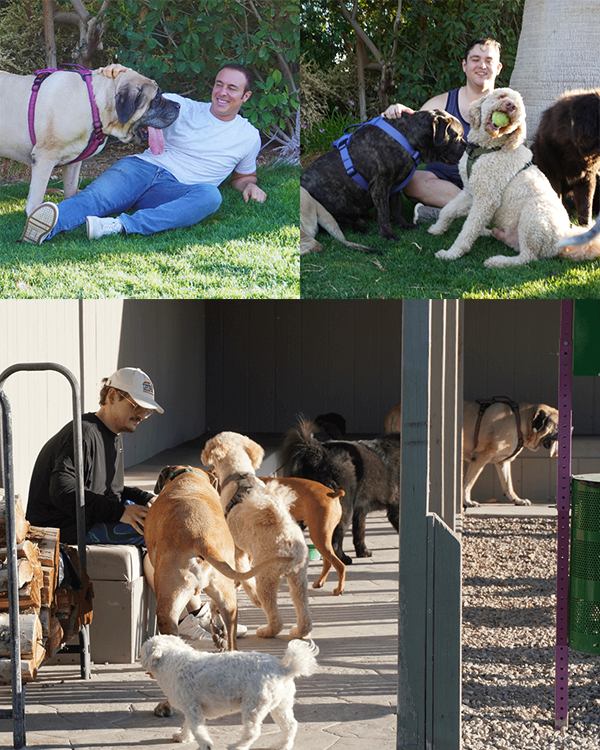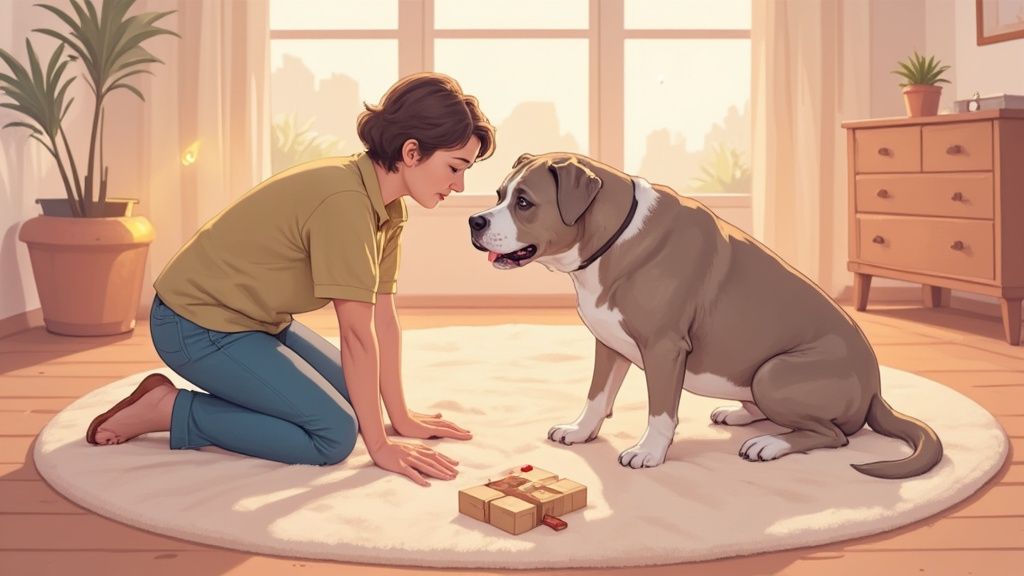
How to Help a Dog with Dementia: A Compassionate Guide
When you're navigating this journey with your senior dog, a multi-faceted approach is always best. Supporting a dog with dementia means blending smart environmental management with consistent routines, gentle enrichment, and targeted nutritional support. But the most important first step? Recognizing those quiet changes and partnering with your veterinarian.
Recognizing When Your Senior Dog Needs You Most
That moment your old friend looks at you with a flicker of confusion can be heartbreaking. You're not just imagining it, and you're definitely not alone in those late-night worries. We understand. Understanding that these changes aren't "bad behavior" but signs of a cognitive shift is the single most powerful thing you can do for them.
These subtle shifts are often the first clues. Maybe your dog stood at the hinge side of the door, waiting patiently for it to open. Perhaps they got lost on the way back from the yard, a path they’ve trotted a thousand times before. Small improvements matter, and noticing these moments is the first step toward progress.
Identifying the Signs of Cognitive Change
Canine Cognitive Dysfunction (CCD), often called dog dementia, is a neurodegenerative condition that shares similarities with Alzheimer's in humans. And it's more common than you might think. For dogs between 15 and 17 years old, the prevalence can be as high as 67.3%.
The shocking part? Because the signs can be so subtle and easily dismissed as "just old age," only a tiny fraction of these cases are ever formally diagnosed—one study found a diagnosis rate as low as 1.8% even when clinical signs were obvious.
This is where you, as their person, become their most important advocate. Learning to spot the signs is the journey we'll take together.
Common Signs of Canine Cognitive Dysfunction at a Glance
Veterinarians often use the acronym DISHAA to categorize the behavioral changes associated with CCD. This framework can help you organize your own observations before speaking with your vet, making that conversation more productive.
| Category (DISHAA) | Behavior You Might Notice | What It Looks Like in Real Life |
|---|---|---|
| Disorientation | Confusion, getting lost, staring | Staring blankly at a wall, getting "stuck" in a corner, seeming lost in your own backyard. |
| Interactions (Altered) | Changes in social behavior | Becoming more withdrawn and less cuddly, or suddenly becoming uncharacteristically clingy or irritable. |
| Sleep-Wake Cycle | Disrupted sleep patterns | Pacing restlessly all night long, then sleeping much more deeply during the day. This is one of the toughest for families. |
| House Soiling | Forgetting housetraining | Having accidents indoors, often without even signaling that they need to go out. |
| Activity (Altered) | Changes in overall activity levels | A sudden loss of interest in playing or going for walks, or repetitive behaviors like licking or pacing. |
| Anxiety | Increased fear or nervousness | Newfound separation anxiety, fear of familiar people or objects, or increased general anxiousness. |
Keeping a simple log of these behaviors—what happened and when—can be incredibly helpful for your veterinarian.
As the data shows, age is the biggest risk factor. The likelihood of a dog developing cognitive issues can nearly double as they move from their early senior years into their golden ones.
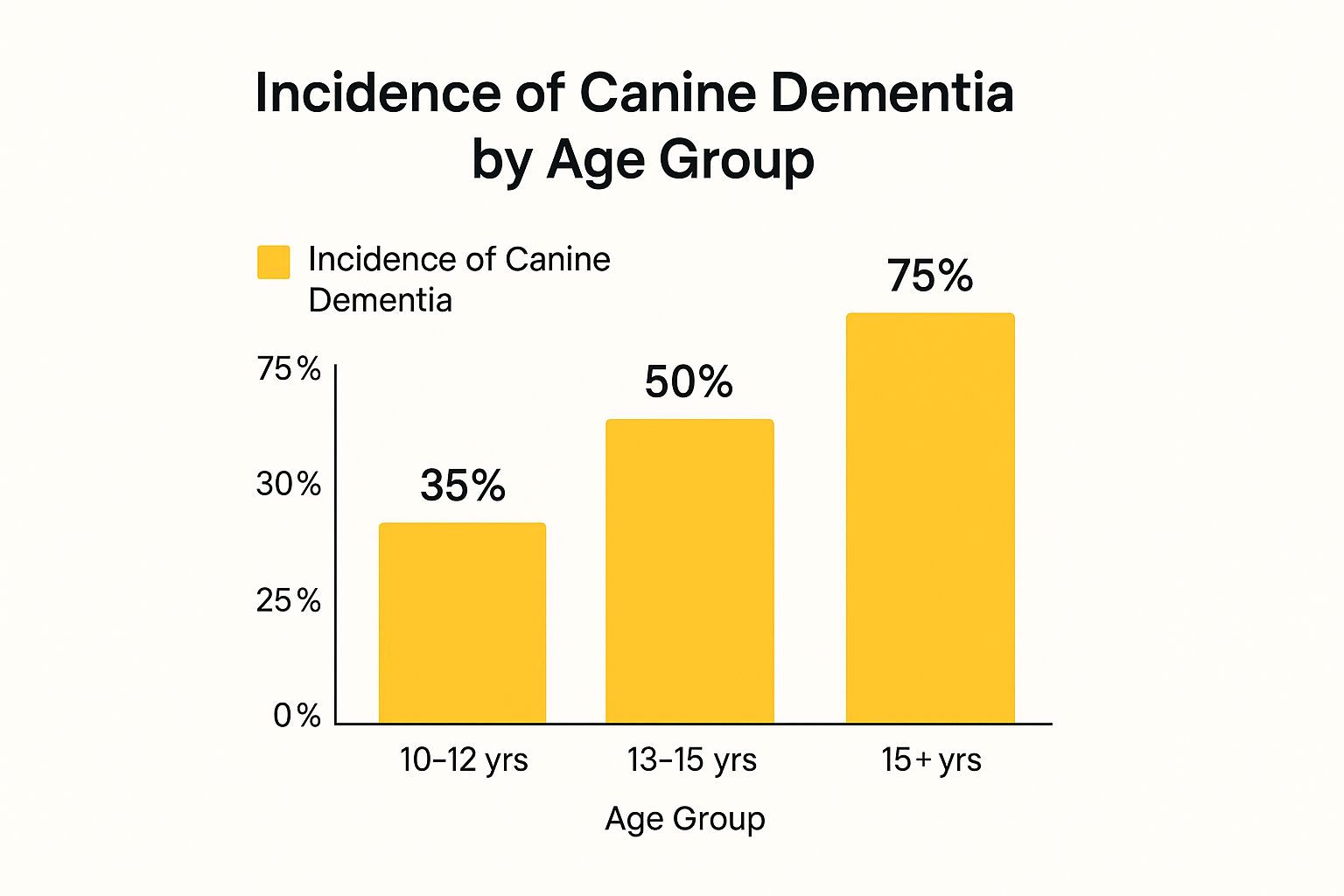
We get it—seeing these changes in your beloved companion is tough. The goal isn't for you to make a diagnosis, but to observe with compassion. Every small detail you notice is a piece of the puzzle that helps you and your vet build the best possible support plan together.
Documenting what you see is the essential next step. Note when the behaviors happen and how often. This information will be invaluable when you talk with your vet. To get a better handle on the nuances, you can learn more about the signs of cognitive decline in dogs in our detailed guide.
Get Your FREE Dog Brain Health Guide

Get instant FREE access to today's top ways to help your best friend live a longer, healthier, happier life.
- 39 value-packed pages of expert insights
- Early-detection tips for cognitive decline
- Top brain-boosting superfoods
- Vet-approved mental sharpness strategies
- Fun IQ tests for your dog
Creating a Calm and Predictable Home Environment
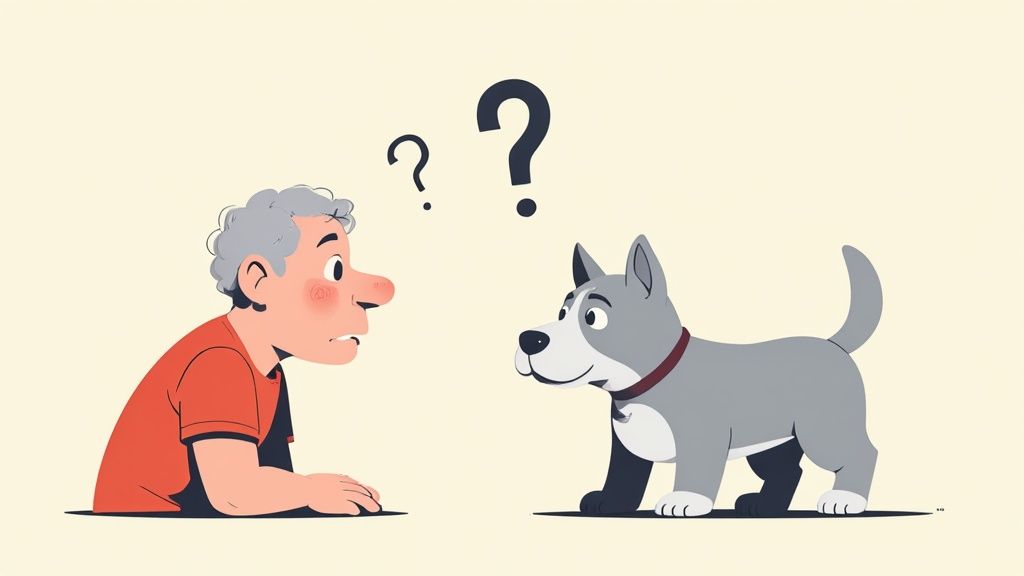
It's heartbreaking to see your old friend seem lost in the very home they've known for years. For a dog navigating cognitive changes, a predictable world is a comforting one. The best thing we can do is make their home the one place they always feel safe and secure.
Think of their daily routine as a steady anchor in a confusing sea. Keeping meals, potty breaks, and bedtime on a consistent schedule creates a rhythm they can count on. This predictability helps them anticipate what’s coming next, which goes a long way in dialing down the stress that comes with surprises and maintaining their comfort.
Simplify Their Space for Safety and Comfort
As your dog’s cognitive function changes, so does their ability to navigate their surroundings. A path they’ve walked a thousand times can suddenly feel like an unfamiliar maze. The goal here is to gently adapt their space, making it as safe and easy to get around as possible.
You can start with a few simple but incredibly effective tweaks:
- Light the Way: Plug in a few extra night lights in hallways, near their bed, and by the water bowl. This small change can make a huge difference in reducing nighttime disorientation and anxious pacing.
- Prevent Slips: Hardwood and tile floors can become tricky for a wobbly senior. Lay down non-slip rugs or runners along their most-used paths to give them secure footing and a confidence boost.
- Keep Essentials in Place: This is a big one—try not to move their food and water bowls or their bed. Knowing exactly where to find these crucial resources provides a massive sense of security.
We’ve been there, and we understand what it's like to love a dog through their golden years. Creating a safe harbor for them at home is one of the most powerful acts of love and support you can offer during this chapter. You’ll be surprised how small environmental changes can lead to big improvements in their peace of mind.
Reducing Hazards and Anxiety Triggers
Now it’s time to look at your home through their eyes and spot things that could be new dangers or sources of stress. A staircase they used to bound up and down might now be a serious fall risk.
Use baby gates to block off stairs or any other areas where they could get into trouble. If you have a pool, double-check that the fence is secure. Clear out cluttered spots where they might get stuck or confused, like behind the couch or in a tight corner.
By simplifying their environment and removing these potential hazards, you’re helping them move through their world with more confidence and less fear. It's all about providing gentle support so they don't have to work so hard just to feel safe, freeing them up for more moments of comfort and clarity.
Gentle Exercise and Mindful Mental Enrichment
Keeping your old friend’s mind and body active is one of the kindest things you can do for them. But let's be realistic—the high-flying games of fetch from their youth might be too much now. The goal shifts from tiring them out to gently stimulating them. We want to support their cognitive health without causing the frustration or confusion that new, complex tasks can bring.
Think of it less like teaching new tricks and more like nurturing the well-worn pathways that are still strong. Simple, familiar activities provide comfort and a sense of purpose, reminding them of old joys and helping to maintain their mental clarity.
Adapting Physical Activity for Comfort
Those long, rambling hikes may be a thing of the past, but gentle movement is more important than ever. It supports healthy circulation and helps maintain muscle tone. The key is to adapt.
Shorter, more frequent walks on the same familiar route can be perfect. This gives them both physical benefits and a deep sense of security. And please, let them sniff! Let them take their time. That slow, deliberate sniffing is a powerful form of mental engagement for a dog.
Don’t just take our word for it. Research has shown that inactive senior dogs were a staggering 6.47 times more likely to develop cognitive issues compared to their active peers. You can read the full study about how activity levels impact canine aging to see just how crucial this is.
Nurturing Their Mind with Gentle Games
When it comes to mental enrichment for a dog with dementia, the goal is success, not challenge. Frustration is the enemy. We want to set them up for small, easy wins that boost their confidence and gently light up their minds.
Here are a few simple ideas to get you started:
- Easy Food Puzzles: Break out a beginner-level snuffle mat or a simple slow feeder with their favorite smelly treats. The idea is to encourage sniffing and searching in a way that’s not too difficult.
- Scent Games: Their sense of smell is often one of the strongest senses to remain. Hide a few high-value treats under a towel or in a cardboard box (with the flaps open) in the same room and cheer them on as they "find it."
- Quiet Connection: Never underestimate the power of simply being together. Sit with them on the floor, offer a gentle massage, or softly brush their coat. This calm, focused interaction is a beautiful and effective form of enrichment.
We measure progress not in complex tasks learned, but in moments of quiet contentment. When your dog successfully nudges a treat out of a puzzle or leans into a calm grooming session, that’s a win. That’s a sign they feel safe, engaged, and loved.
Remember, the goal is simply to add pleasant, stimulating experiences to their day that help maintain what’s still there. These activities do more than just pass the time; they strengthen your bond and provide immense comfort, which is what they need most. For more ideas on this, check out our other articles on canine brain health. It’s all about creating more good days together.
Supporting Brain Health Through Nutrition
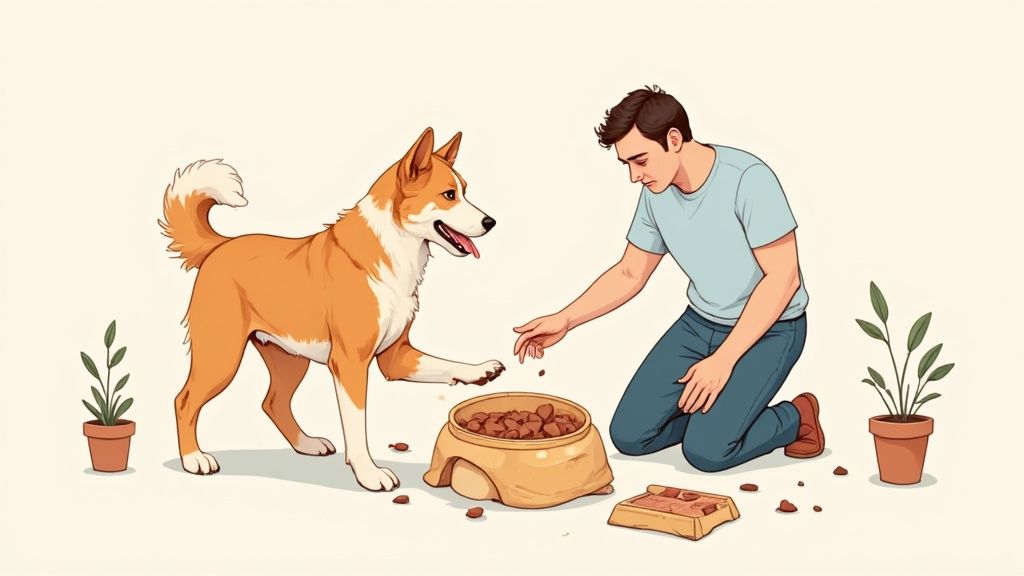
What you put in your dog's bowl is one of the most powerful tools you have on this journey. Sorting through all the nutritional advice out there can feel overwhelming, but focusing on targeted support for your dog's brain health can make a real, noticeable difference in their comfort and clarity.
Think of it this way: their aging brain needs specific building blocks to maintain function, just like their body needs the right fuel. Over the years, a natural process called oxidative stress can affect brain cells. This is where the right nutrition can step in to provide gentle, natural support.
Key Nutrients for Cognitive Maintenance
You don't need to be a canine nutritionist to make smart choices. A handful of key ingredients are well-known for their ability to support the brain’s natural defense systems and promote healthy function. These aren't magic bullets, but they are foundational elements for supporting brain cells and promoting mental clarity.
Here are a few of the most impactful nutrients to look for:
- Antioxidants (like Vitamins E and C): These act like cellular bodyguards. They help protect brain cells from the oxidative stress that naturally accumulates with age.
- Omega-3 Fatty Acids (especially DHA): DHA is a superstar fat for brain health. It’s a crucial structural component of brain cell membranes, helping them communicate effectively with each other.
- Medium-Chain Triglycerides (MCTs): Found in sources like coconut oil, MCTs offer an alternative energy source for the brain. This is incredibly helpful, as an aging dog's brain can sometimes struggle to use its primary fuel, glucose.
You're not just feeding their body; you're feeding their mind. Every meal is an opportunity to provide the gentle support their brain needs to navigate its day with a little more ease and recognition. Small dietary changes can lead to progress you can see.
The Role of Targeted Nutritional Supplements
While a balanced diet is the cornerstone of good health, an older dog's needs often call for a more focused approach. This is where a high-quality supplement can be a game-changer. It delivers powerful, specific ingredients in concentrations that are almost impossible to achieve through diet alone.
For anyone wondering how to truly help a dog with dementia, certain ingredients are consistently highlighted for their direct role in supporting brain health:
- Phosphatidylserine: This is a natural fat that's a vital part of brain cell membranes. Supporting healthy levels helps maintain the brain's ability to send and receive signals, which can promote mental clarity.
- SAMe (S-adenosylmethionine): A molecule found naturally in the body, SAMe supports the production of key neurotransmitters—the chemical messengers that influence everything from mood to cognitive function.
- Beet Root Powder: This simple ingredient supports healthy blood flow. Good circulation is absolutely essential for delivering oxygen and nutrients to the brain, making it a key piece of the cognitive health puzzle.
Trying to find the right combination of these can feel like a complex puzzle. To make it simpler, we’ve created a guide that breaks down the most effective options available. You can explore our complete overview of the best dog dementia supplements to see how these elements work together. The goal is always the same: providing gentle, natural support for more good days together.

Support Your Dog's Brain Health with NeuroChew™
As mentioned in this article, NeuroChew is the first dog chew designed to support both cognitive function and healthy circulation. Perfect for dogs showing early signs of cognitive decline or for proactive brain health support.
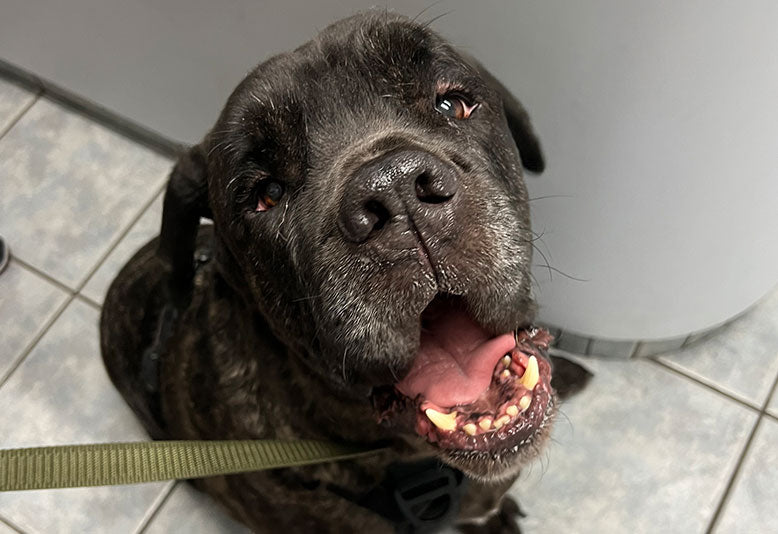
Real Results: How NeuroChew Helped Brutus Regain His Mental Clarity
Brutus was getting disoriented at night. After starting NeuroChew, he's more happy during the day and steady at night. He's back to his old self!
Your Vet Is Your Most Important Partner
When you're navigating something as complex as canine dementia, your veterinarian isn't just a doctor—they're your co-pilot on this journey. It's so easy to see the little changes, like the nighttime pacing or getting "stuck" behind a chair, and write them off as just "old age." But you know your dog better than anyone.
You are their number one advocate. Voicing your concerns is the first, most critical step in getting your old friend the support they need. This isn't just another check-up; it's the start of a new care plan, and you're the one who has to get the ball rolling.
How to Talk to Your Vet About It
It can feel a bit strange trying to explain these behaviors. The best approach? Be a good detective. Instead of saying, "I think he's confused," give your vet concrete examples they can work with. Before you go, grab a notebook and jot down what you've seen.
This isn't just helpful; it's essential for a proper diagnosis. Think of yourself as a field researcher providing the raw data.
- What exactly are you seeing? Instead of "he's anxious," try "he starts panting and pacing between the living room and the kitchen every night around 9 PM." Specifics are everything.
- When does it happen? Is the disorientation worse after a nap? Does the barking start right after the sun goes down? Note the time and context.
- How often? Is this a once-a-week thing, or is it now a nightly ritual? Tracking the frequency helps your vet understand the progression.
- Any obvious triggers? Does the confusion ramp up when you have guests over? Or maybe when you move a piece of furniture?
Providing this level of detail helps your vet see the full picture and connect the dots. You're not just another 15-minute appointment; you're an active partner in your dog's health journey.
A study of dogs aged 7 and up found a pretty shocking communication gap. While 75% of owners saw at least one behavioral sign of cognitive decline, a mere 12% ever brought it up with their vet. That's a huge number of dogs potentially struggling in silence because the conversation never happened. You can learn more about this study in Today's Veterinary Practice.
What to Expect at the Vet's Office
Once you've laid out your concerns, your vet will shift into diagnostic mode. Their first job is to rule out other medical conditions, because a lot of different ailments can look surprisingly like dementia.
Things like confusion or house-soiling aren't always what they seem in an older dog. Your vet will conduct a full physical exam and will probably recommend blood work to check for common culprits that can cause similar symptoms, such as:
- Loss of hearing or sight
- Arthritis pain that might cause restlessness or reluctance to move
- A pesky urinary tract infection (UTI)
- Kidney issues or thyroid imbalances
This methodical approach ensures you're helping with the right problem. By teaming up, you and your vet can build a comprehensive plan that addresses all of your dog's needs, giving both of you more good days together.
Your Questions on Dog Dementia Answered
https://www.youtube.com/embed/9bAk-zXBwkk
We know this journey comes with a lot of questions—the kind that tend to pop into your head at 3 AM. You're definitely not alone in wondering about these things. Let's walk through some of the most common and heartfelt questions we hear from pet parents who are right where you are.
Can Dog Dementia Be Reversed or Cured?
This is the first question every loving owner asks, and it comes straight from the heart. The honest answer is that, right now, there is no cure for Canine Cognitive Dysfunction. Facing the reality that it’s a progressive condition is incredibly tough.
But that doesn’t mean we’re helpless. While we can't turn back the clock, we can absolutely make a difference. A thoughtful approach that combines environmental support, gentle enrichment, the right nutrition, and veterinary care can help manage the signs and support a slower progression.
The goal isn't a miracle cure. It's about supporting your dog's brain health to give you both more good days together. We measure success in peaceful nights, moments of recognition, and the quiet comfort you share.
How Do I Know if It’s Just Old Age?
It's such a blurry line, isn't it? This is one of the biggest sources of worry for senior dog owners. While some general slowing down is a perfectly normal part of aging, the behaviors tied to cognitive decline are distinctly different.
"Old age" might look like sleeping more soundly or taking an extra minute to get up from a nap. Canine Cognitive Dysfunction, on the other hand, involves real changes in learned behaviors and a sense of confusion that wasn't there before.
- Normal Aging: Your dog might be a little slower to respond when you call their name.
- Cognitive Decline: Your dog no longer seems to recognize their own name or forgets commands they've known for a decade.
The key is looking for a pattern of cognitive changes—forgetting familiar routes on a walk, getting stuck in corners, or staring blankly at walls. Keeping a simple log of these specific moments is the best way to give your vet a clear picture of what's happening.
How Long Does Nutritional Support Take to Work?
Patience and consistency are your two best friends here. Every dog's body and situation is unique, so there’s no universal timeline for seeing results.
That said, many families tell us they start noticing small but meaningful improvements within about 4 to 6 weeks of starting a targeted nutritional supplement. The first signs of progress are often subtle, so you have to be looking for them.
Maybe your dog is sleeping more soundly through the night instead of pacing the halls. Or perhaps they seem a little more "present" when you talk to them, or they navigate from the living room to their water bowl with more confidence. These small wins are absolutely worth celebrating—they’re proof that the support you’re providing is making a real difference.
At Furever Active, our mission is to provide that support. We created NeuroChew™ to help maintain cognitive function and promote mental clarity for dogs just like yours. Discover how our dual-action formula can support your dog’s brain health on this journey.
Share This Article

Support Your Dog's Brain Health with NeuroChew™
The first dog chew that supports both brain function and healthy circulation. Perfect for dogs of all ages.
- Enhances cognitive function & mental clarity
- Reduces anxiety without sedation
- Supports healthy blood circulation
- Made in USA with natural ingredients
60-Day Money-Back Guarantee • Free Shipping




